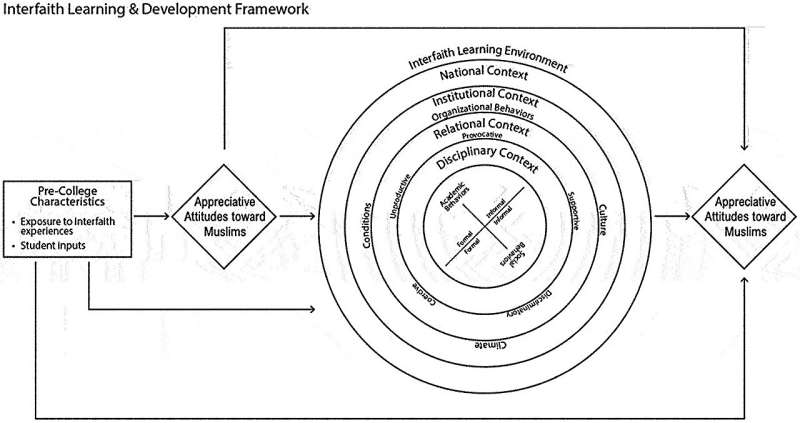
The Interfaith Learning and Development Framework (Mayhew & Rockenbach, Citation2021). Credit: The Journal of Higher Education (2023). DOI: 10.1080/00221546.2023.2251868
New research published by Musbah Shaheen, assistant professor of higher education, and colleagues at Ohio State University, North Carolina State University and Mississippi State University suggests that college environments play a vital role in combating Islamophobia.
The article, published in the Journal of Higher Education, finds that non-Muslim students are more likely to develop positive attitudes toward Muslims when they participate in two or more social engagements that intend to bridge religious and spiritual differences. This work builds upon their previous research that focused specifically on students’ first year of college and the impact that time can have on interfaith engagement.
The study utilizes data from the Interfaith Diversity Experiences and Attitudes Longitudinal Survey (IDEALS) project, which followed thousands of students attending 122 colleges and universities across their four years in college. IDEALS has been used in other research projects, as well, including studies that explored attitudes toward Jews and Evangelicals.
“If we want to prepare students to interact productively with an increasingly diverse and global world, we need to provide them with the opportunity to engage across lines of difference in all its forms, including religious differences,” Shaheen said.
Higher education plays a crucial role in presenting these opportunities, Shaheen said, but noted that tensions around diversity, equity and inclusion (DEI) work on university and college campuses complicate their implementation.
Based on these findings, educators and administrators alike can take immediate steps to enhance their classrooms and administrative spaces beginning with identifying the support programs, structures and policies that exist within their office, department or college to support the needs of students with diverse religious and spiritual backgrounds.
More information:
Musbah Shaheen et al, Latent Growth Modeling of the Attitudes of Non-Muslims Toward Muslims in College: A Longitudinal Analysis, The Journal of Higher Education (2023). DOI: 10.1080/00221546.2023.2251868
Citation:
Research finds interfaith engagement in college environments combats Islamophobia (2023, September 14)
retrieved 4 October 2023
from https://phys.org/news/2023-09-interfaith-engagement-college-environments-combats.html
This document is subject to copyright. Apart from any fair dealing for the purpose of private study or research, no
part may be reproduced without the written permission. The content is provided for information purposes only.
Note: This article have been indexed to our site. We do not claim legitimacy, ownership or copyright of any of the content above. To see the article at original source Click Here













